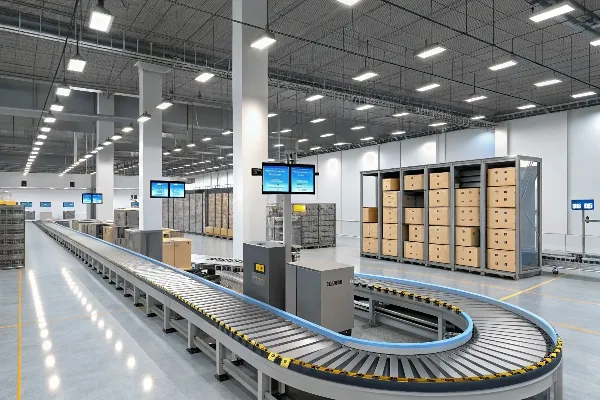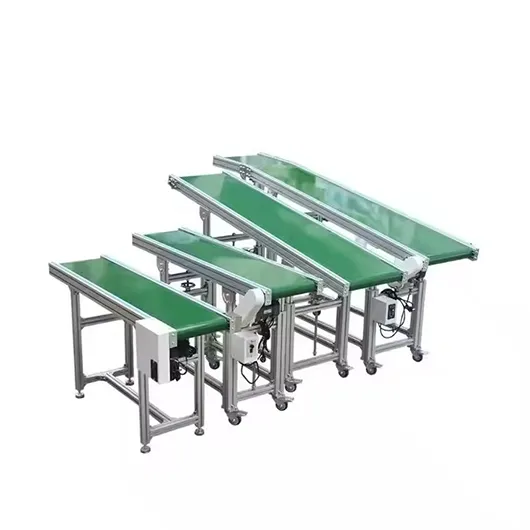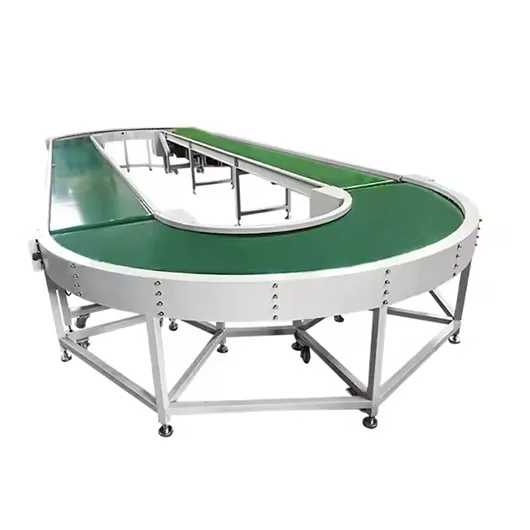Para evitar atrasos na resposta ao seu pedido, indique o seu WhatsApp/Skype juntamente com a mensagem, para que possamos contactá-lo logo na primeira vez.
Responder-lhe-emos no prazo de 24 horas. Se for um caso urgente, adicione WhatsApp/WeChat: ,. Ou telefone diretamente.
Inefficiency and downtime in your production line can drain profits fast. When manual handling or outdated conveyor belt systems slow things down, it leads to lost productivity, safety risks, and extra costs. A modern conveyor belt solution is the proven way to automate, streamline, and scale your operations.
A conveyor belt is a flexible, continuous loop that moves materials or products efficiently along a set path in a conveyor system. Powered by pulleys and supported by rollers, conveyor belts are vital for automating transport in manufacturing, warehousing, and logistics.

A conveyor belt is much more than a moving strip—it’s the backbone of today’s automated material handling. A standard belt conveyor consists of a durable belt (usually made of PVC, rubber, or fabric), drive pulleys, idler rollers, a conveyor frame, and a motorized control system.
How Conveyor Belts Work:
Key Components of a Belt Conveyor:
| Componente | Função |
|---|---|
| Correia transportadora | Moves items along the system |
| Drive Pulley | Powers the belt |
| Idler Rollers | Support the belt and reduce friction |
| Conveyor Frame | Provides structure and stability |
| Belt Tension System | Maintains proper tension for smooth operation |
| Sistema de controlo | Automates operation, often with variable frequency |
“A well-designed conveyor belt system can reduce manual handling by over 60%, improve throughput by 50%, and cut labor costs significantly.”
— Industry Materials Handling Study, 2024
Fun Fact:
The first conveyor belts date back to the late 19th century and were used in coal mines for bulk material transport. Today, sistemas de transportadores de correia are found in almost every industry.
Types of Conveyor Belts:
| Tipo | Features & Benefits | Ideal Use Cases |
|---|---|---|
| Cinto plano | Smooth surface, simple design | Packing lines, product inspection |
| Modular Belt | Plastic interlocking pieces, easy repair | Food, beverage, pharma, curved layouts |
| PVC Belt | Chemical/abrasion resistant, easy to clean | Warehousing, logistics, e-commerce |
| Fabric Conveyor | Lightweight, flexible, gentle on products | Electronics, light manufacturing |
| Rubber Belt | Heavy-duty, high friction, rugged | Mining, aggregate, construction |
| Trough Belt | Curved sides, contain bulk materials | Agriculture, sand/gravel transport |
| Curved Conveyor | Follows facility curves, saves space | Airports, retail logistics, assembly |
Exemplo de sector:
A large logistics distribution center replaced manual trolleys with a PVC belt conveyor system, reducing material transport time from 10 minutes per trip to less than 2 minutes—boosting daily throughput by 300%.
Types of Conveyor Belt Systems:
Explore real-world belt conveyor lines engineered for flexible, automated workflows.

Choosing the right conveyor belt material impacts lifespan, maintenance, and efficiency.
| Material | Strengths | Weaknesses | Typical Uses |
|---|---|---|---|
| PVC | Chemical resistant, easy clean, low cost | Not for high heat | Warehousing, food, pharma |
| Rubber | Excellent grip, durable, abrasion resistant | Heavy, less flexible | Mining, outdoor, aggregate |
| Fabric | Lightweight, flexible, gentle on goods | Limited abrasion resistance | Packaging, electronics |
| PU (Polyurethane) | Food-safe, high cut resistance | Costlier | Food handling, pharma |
| Modular Plastic | Snap-in repairs, water-resistant | Louder operation | Food processing, bottling |
| Steel Mesh | Heat/corrosion resistant, heavy-duty | Expensive, noisy | Baking, drying lines |
PVC Belt Case Study:
A European e-commerce warehouse chose PVC belts for their picking and packing lines. Result: 99.7% uptime, no belt failure in the first 18 months, and fast cleaning cycles.
Table: Conveyor Belt Selection Guide
| Aplicação | Recommended Belt Type | Why? |
|---|---|---|
| Bulk materials | Trough/rubber | High load, abrasion resistance |
| Food processing | Modular/PU | Hygienic, easy to clean |
| Eletrónica | Fabric | Gentle handling, low static |
| Warehousing | PVC/modular | Durable, adaptable |
| Assembly lines | Flat/modular | Versatile, customizable |
Selecting the ideal belt width and length is critical to ensuring smooth material flow and safety.
“Proper belt sizing ensures up to 40% fewer conveyor belt failures and maximizes lifespan.”
— conveyor belt manufacturersAssociation Report, 2023
Tips:
Rollers and pulleys are at the heart of efficient conveyor belt operation:
Visual Table: Typical Roller Arrangement
| Roller Position | Função |
|---|---|
| Head (Drive) Pulley | Moves and powers the belt |
| Tail Pulley | Maintains belt tension |
| Idler Rollers | Support and guide the belt |
| Wing Rollers | Keep return belt free of debris |
Common Problem:
Misaligned rollers lead to belt tracking issues and increased downtime.
See our roller conveyor systems for heavy-duty industrial applications.
Proper maintenance extends the lifespan of your conveyor belts and prevents costly breakdowns.
“A well-maintained conveyor belt can last over 5 years even in continuous-use environments.”
— Industry Operations Study, 2022
Belt speed is a critical variable in every conveyor belt system. It determines how fast products move, impacts safety, and affects the overall efficiency of your production line.
“Implementing variable frequency drives in your conveyor system is like giving your production line a turbo boost—flexibility, efficiency, and savings, all in one.”
— Senior Automation Engineer, Fortune 500 Logistics Company
Read about motorized conveyor solutions with adjustable speed options.
Today’s manufacturing and distribution centers need flexible, easily reconfigurable conveyor systems.
Estudo de caso:
A global electronics company needed to route products through a crowded factory. Switching to modular curved conveyor belts eliminated three manual transfer stations, saving 80 labor hours per week.
Discover custom modular conveyor lines that fit your unique facility layout.

Tempo de inatividade is the enemy of modern manufacturing. Fortunately, most conveyor belt failures can be avoided or quickly fixed with proactive care.
| Failure Type | Likely Cause | Quick Fixes / Prevention |
|---|---|---|
| Misalignment | Worn idler rollers, loose frame | Adjust or replace rollers |
| Belt Slip | Incorrect belt tension, worn drive pulley | Reset tension, check pulley grip |
| Splice Failure | Badly done or aged splicing | Professional re-splicing |
| Material Buildup | Dirt on pulleys, under the belt | Regular cleaning, install scrapers |
| Edge Wear | Poor tracking, frame misalignment | Adjust tracking, inspect regularly |
| Premature Wear | Wrong belt material for application | Use abrasion-resistant belt material |
Stat: Companies with proactive conveyor belt maintenance programs report 60% less unexpected downtime than those using reactive strategies.
%conveyor belt maintenance in progress
Your conveyor solution should match your product and environment. Consider these advanced options:
Checklist for Conveyor Belt System Design:
Explore our full range of conveyor equipment solutions for every industry.
How long does a conveyor belt typically last?
With proper maintenance, the average lifespan of a conveyor belt ranges from 3 to 7 years. In harsh environments or with heavy loads, that may shorten, but regular inspection and the right belt material can greatly extend belt life.
Can a conveyor belt be repaired or does it need full replacement?
Minor damage (like surface nicks or edge wear) can often be repaired by patching or splicing. Modular belt conveyors are especially easy to fix—just snap in new segments.
What’s the best way to clean a conveyor belt?
Use a combination of scrapers, brushes, and regular washing for food and pharma belts. For PVC or rubber belts in warehousing or logistics, compressed air and damp wipes are effective.
How do I know if my conveyor belt tension is correct?
A properly tensioned belt doesn’t slip or sag. Most modern systems have a take-up system or tensioning device—check the manufacturer’s guide for specs.
What certifications should I look for in a conveyor system?
Look for belts and systems that meet ISO, CE, or FDA requirements (for food applications). Certified conveyor manufacturers provide documentation for safety and quality.
Is a belt conveyor or a roller conveyor better for my application?
Belt conveyors handle smaller, irregular, or soft items. Roller conveyors are best for sturdy, flat-bottomed products like boxes and pallets.
Case Study: Automated PVC Belt Conveyor in E-Commerce
An e-commerce giant faced bottlenecks during peak sales. After installing an automated PVC belt conveyor system with VFD controls, order processing speed doubled. Downtime dropped to less than 1% of operational hours. The flexible belt design allowed easy system upgrades as the business grew.
Key Results:
“Switching to a modern belt conveyor system revolutionized our material flow. Now we can scale up every sales season with zero manual headaches.”
– Logistics Manager, Top 10 Global E-Commerce Brand
| Métrica | Manual Handling | Old Conveyor Belt | Modern Belt Conveyor System |
|---|---|---|---|
| Average Downtime (hrs/mo) | 12 | 4 | 1 |
| Avg. Items Moved/hr | 150 | 800 | 1200 |
| Labor Cost (% savings) | – | 35% | 65% |
| Safety Incidents/year | 5 | 2 | 0 |
%industrial conveyor belt performance comparison